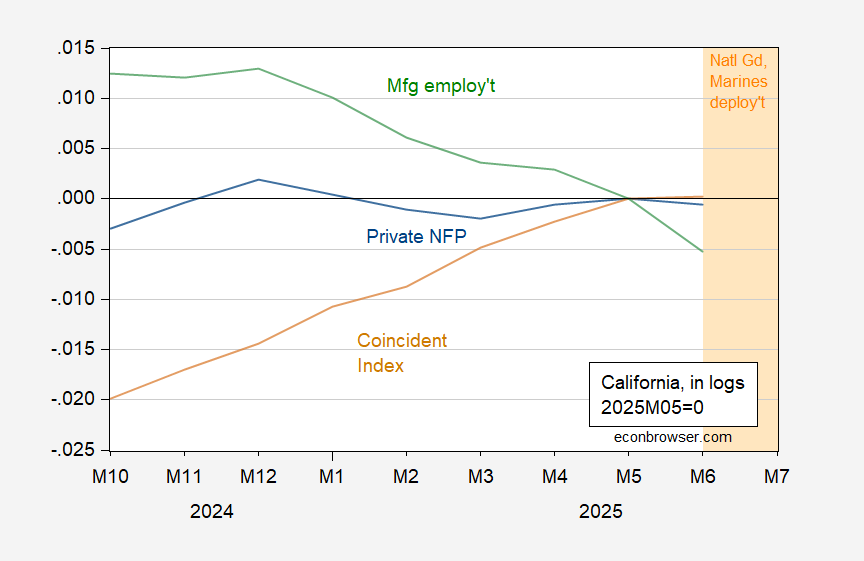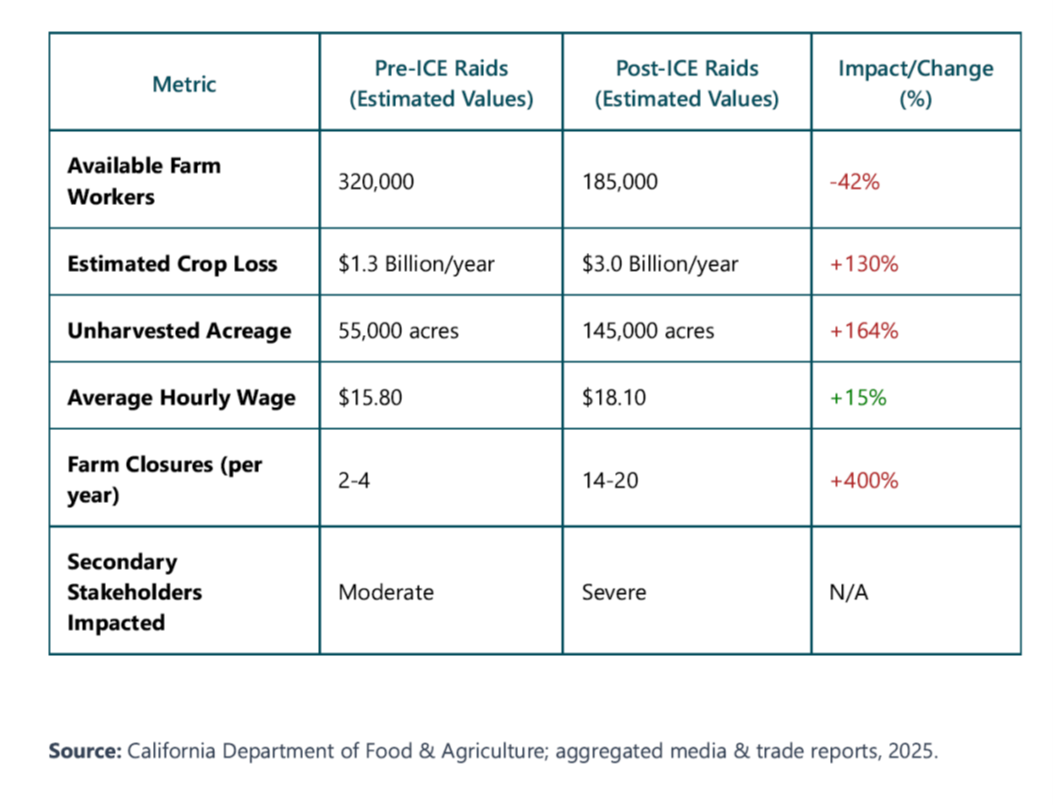On June 7, President Trump federalized the California National Guard and deployed troops to LA. This followed instances of aggressively conducted ICE raids against various establishments. Economic activity declined in both LA and rural areas engaged in agriculture.
Here are some aggregate indicators for California.
Figure 1: California private nonfarm payroll employment (blue), manufacturing (green), and coincident index (tan), all in logs, 2025M05=0. Source: BLS via FRED, BLS, Philadelphia Fed, and author’s calculations.
Private NFP declined in June. The coincident index (released today) exhibits a sharp break in June. Finally, manufacturing employment shrinkage accelerated in June. One might not think of manufacturing as a big employer of undocumented immigrants, but in fact the deportation/removal policy will impact this sector tremendously.
Notice that given the federalized National Guard deployment is not yet over, and ICE raids continue, it’s likely that we will see more effects in the July statistics. Income statistics will show impacts later on. We have some estimates on the impact in the agricultural sector from Farmonaut (undated).
Source: Farmonaut (undated).
Without knowing the exact sources, it’s difficult to assess the plausibility of these estimates. But it can’t be a positive economic impact.


The Art of the Deal.
Trump, used his patented “strategic uncertainty” negotiating skills in an agreement with Japan. So GM and Ford will have to deal with 50% steel tariffs and 50% copper tariffs and 25% Mexican auto parts tariffs and 25% Canadian auto part tariffs.
And then Japan can just import their finished cars with a 15% tariff. Toyota stock jumped 13% today. Are you tired of winning yet?
Looks like the data stops in Figure 1 at M6, not showing what the effect of ICE raids and violation of Posse Comitatus law was.
Macroduck: The federalized California National Guard was sent in on June 7. The BLS CES surveys are approximately in the 2nd week of the mont, so would probably catch the beginning of the occupation. But definitely, we would want July figures to make a more definitive conclusion.
Off topic, and I’m really sorry for pursuing my little hobby here, especially since really important stuff is going on, but – a little monetary history, a little forensic economics:
https://www.nature.com/articles/s41562-024-01926-4
For those without institutional access (like me), here’s a write up of the study:
https://www.sciencedaily.com/releases/2024/08/240801121825.htm
The gist is, bronze objects from Middle European hoards are found to be of standardized weights, starting around 1500 BC. The supposition is made that standardization indicates that bronze objects were used as money. The authors then looked at the weight distribution of the objects (over 20,000 objects from over 1,000 hoards) and discovered that, if these bronze objects were used as money, then spending patterns 3,500 years ago were similar to patterns today, with the proportion of small vs large purchases similar similar to today.
The implication is that these pre-literate Bronze Age economies, far from the Great Civilizations of their day, may have used money routinely in daily life.
A further finding is that standardized sizes of bronze objects were common across these hoards. The implication here is that monetary units were standardized over a wide geography, suggesting that trade over distance was common enough to standardize money.
For those who don’t keep up on Bronze Age archeology, here’s the thing – there are thousands of bronze hoards all over the place. When researchers find a commonality like that, they try to figure out the behavior behind it: Why are ten identical ax heads found dumped together, over and over – why are there hoards? Why are expensive resources laid up together, instead of being found in situations which suggest they were lost while in use? Often, the guess is that some religious ritual is involved. Money could be the answer. One more thing. We kinda know that objects were used as money in the Iron Age. For instance, iron tripods were given as athletic prizes in Iron Age Greece, when the athletes’ families almost surely already had cooking tripods at home. Why? Because an iron tripod represented a fixed value. This study may push back the dating of objects-as-money in Middle Europe and solve a longstanding mystery. I’m really impressed.
By the way, Hammurabi’s Code laid down usury rules around 1,800 BC and the Laws of Manu around 2,300 BC, so credit predated the standardization of bronze objects in these hoards. Not sure we’ll ever know whether money or credit came first.
How do they get to 135,000 farm workers removed? Is there a way to measure this directly?
Optimistic but Sceptic: That was my caveat. You have to ask Farmonaut.